Estimation of Soil Organic Carbon Content in Coastal Wetlands with Measured VIS-NIR Spectroscopy Using Optimized Support Vector Machines and Random Forests
Abstract
:1. Introduction
2. Materials and Methods
2.1. Datasets
2.1.1. Soil Samples
2.1.2. Spectral Data
2.2. Methodology
2.3. Model Development
2.3.1. Grid Search Method
2.3.2. Optimized Support Vector Machine Regression
2.3.3. Optimized Random Forest Regression
2.3.4. Statistical Analyses
2.3.5. Model Validation
3. Results
3.1. Descriptive Statistics of CW-SOC
3.2. Selection of CW-SOC Characteristic Wavelengths
3.3. Model Performance Comparison
4. Discussion
4.1. CW-SOC Content of Different Soil Textures
4.2. Spectral Feature Wavelengths of CW-SOC
4.3. Model Algorithm Comparison Evaluation
5. Conclusions
- (1)
- The correlation between organic carbon content and the spectrum of sandy soil in coastal wetlands is significantly higher than that of silty soil. The characteristic wavelengths related to SOC of silty soil are mainly in the spectral range of 500~1000 nm and 1900~2400 nm, and that of sandy soil is mainly in the spectral range of 600~1400 nm and 1700~2400 nm.
- (2)
- In comparing the two methods, the OSVR method has been proven better than the ORFR method. The organic carbon prediction model of silty soil based on the OSVR method under the R′ transformation is the best, with the Adjusted-R2 value as high as 0.78, the RPD value is much greater than 2.0 and 5.07, and the RMSE value as low as 0.07. Both OSVR and ORFR methods can improve the prediction results of the model. OSVR method can improve the performance of the model by about 15~30%, and the ORFR method can improve by about 3~5%. OSVR method is better than the ORFR method.
- (3)
- The OSVR and ORFR can be used as better methods to accurately predict the soil organic carbon content of coastal wetlands and provide data support for the carbon cycle, soil conservation, plant growth, and environmental protection of coastal wetlands.
Author Contributions
Funding
Data Availability Statement
Conflicts of Interest
Abbreviations
| Abbreviations | Definition |
| CW-SOC | Coastal wetland soil organic carbon |
| SOC | Soil organic carbon |
| OSVR | Optimized support vector machine regression |
| ORFR | Optimized random forest regression |
| LOO | Leave-one-out |
| Adjusted-R2 | Adjusted coefficient of determination |
| RPD | Root mean square error |
| RMSE | Residual predictive deviation |
| VIS-NIR | Visible-near-infrared |
| SVM | Support vector machines |
| RF | Random forests |
| GS | Grid search |
| S-G | Savitzky-Golay |
| R | Reflectance |
| 1/R | Reflectance reciprocal |
| Log(1/R) | Reciprocal logarithm of reflectance |
| R′ | First-order differential of reflectance |
| CR | Removal continuum of reflectance |
| SD | Standard deviation |
References
- Ortega, A.; Geraldi, N.R.; Alam, I.; Kamau, A.A.; Acinas, S.G.; Logares, R.; Gasol, J.M.; Massana, R.; Krause-Jensen, D.; Duarte, C.M. Important contribution of macroalgae to oceanic carbon sequestration. Nat. Geosci. 2019, 12, 748–754. [Google Scholar] [CrossRef]
- Kottkamp, A.I.; Jones, C.N.; Palmer, M.A.; Tully, K.L. Physical protection in aggregates and organo-mineral associations contribute to carbon stabilization at the transition zone of seasonally saturated wetlands. Wetlands 2022, 42, 40. [Google Scholar] [CrossRef]
- Xia, S.; Song, Z.; Van Zwieten, L.; Guo, L.; Yu, C.; Wang, W.; Li, Q.; Hartley, I.P.; Yang, Y.; Liu, H.; et al. Storage, patterns and influencing factors for soil organic carbon in coastal wetlands of china. Glob. Chang. Biol. 2022. [Google Scholar] [CrossRef] [PubMed]
- Chen, Q.; Yang, R.; Zhu, C. Vis-nir spectroscopy-based prediction of soil organic carbon in coastal wetland invaded by spartina alterniflora. Acta Pedol. Sin. 2021, 58, 694–703. [Google Scholar]
- He, M.; Mo, X.; Meng, W.; Li, H.; Xu, W.; Huang, Z. Optimization of nitrogen, water and salinity for maximizing soil organic carbon in coastal wetlands. Glob. Ecol. Conserv. 2022, 36, e02146. [Google Scholar] [CrossRef]
- Minick, K.J.; Mitra, B.; Li, X.; Fischer, M.; Aguilos, M.; Prajapati, P.; Noormets, A.; King, J.S. Wetland microtopography alters response of potential net co2 and ch4 production to temperature and moisture: Evidence from a laboratory experiment. Geoderma 2021, 402, 115367. [Google Scholar] [CrossRef]
- Zhang, Z.; Wang, Y.; Zhu, Y.; He, K.; Li, T.; Mishra, U.; Peng, Y.; Wang, F.; Yu, L.; Zhao, X.; et al. Carbon sequestration in soil and biomass under native and non-native mangrove ecosystems. Plant Soil 2022. [Google Scholar] [CrossRef]
- Liu, X.; Lu, X.; Yu, R.; Sun, H.; Li, X.; Li, X.; Qi, Z.; Liu, T.; Lu, C. Distribution and storage of soil organic and inorganic carbon in steppe riparian wetlands under human activity pressure. Ecol. Indic. 2022, 139, 108945. [Google Scholar] [CrossRef]
- Li, J.; Han, G.; Wang, G.; Liu, X.; Zhang, Q.; Chen, Y.; Song, W.; Qu, W.; Chu, X.; Li, P. Imbalanced nitrogen-phosphorus input alters soil organic carbon storage and mineralisation in a salt marsh. Catena 2022, 208, 105720. [Google Scholar] [CrossRef]
- Wang, G.X.; Ma, H.Y.; Qian, J.; Chang, J. Impact of land use changes on soil carbon, nitrogen and phosphorus and water pollution in an arid region of northwest china. Soil Use Manag. 2004, 20, 32–39. [Google Scholar] [CrossRef]
- Qi, Q.; Zhang, D.; Zhang, M.; Tong, S.; Wang, W.; An, Y. Spatial distribution of soil organic carbon and total nitrogen in disturbed carex tussock wetland. Ecol. Indic. 2021, 120, 106930. [Google Scholar] [CrossRef]
- Lei, D.; Jiang, L.; Wu, X.; Liu, W.; Huang, R. Soil organic carbon and its controlling factors in the lakeside of west mauri lake along the wetland vegetation types. Processes 2022, 10, 765. [Google Scholar] [CrossRef]
- Mao, D.H.; Wang, Z.M.; Li, L.; Miao, Z.H.; Ma, W.H.; Song, C.C.; Ren, C.Y.; Jia, M.M. Soil organic carbon in the sanjiang plain of china: Storage, distribution and controlling factors. Biogeosciences 2015, 12, 1635–1645. [Google Scholar] [CrossRef]
- Trumbore, S.E.; Czimczik, C.I. An uncertain future for soil carbon. Science 2008, 321, 1455–1456. [Google Scholar] [CrossRef]
- Liu, X.; Tan, S.; Song, X.; Wu, X.; Zhao, G.; Li, S.; Liang, G. Response of soil organic carbon content to crop rotation and its controls: A global synthesis. Agric. Ecosyst. Environ. 2022, 335, 108017. [Google Scholar] [CrossRef]
- McKenna, M.D.; Grams, S.E.; Barasha, M.; Antoninka, A.J.; Johnson, N.C. Organic and inorganic soil carbon in a semi-arid rangeland is primarily related to abiotic factors and not livestock grazing. Geoderma 2022, 419, 115844. [Google Scholar] [CrossRef]
- Paula, R.R.; Calmon, M.; Lopes-Assad, M.L.; Mendonca, E.d.S. Soil organic carbon storage in forest restoration models and environmental conditions. J. For. Res. 2021, 33, 1123–1134. [Google Scholar] [CrossRef]
- Minasny, B.; McBratney, A.B.; Malone, B.P.; Wheeler, I. Digital mapping of soil carbon. Adv. Agron. 2013, 118, 1–47. [Google Scholar]
- Ribeiro, S.G.; Teixeira, A.d.S.; de Oliveira, M.R.R.; Costa, M.C.G.; Araujo, I.C.d.S.; Moreira, L.C.J.; Lopes, F.B. Soil organic carbon content prediction using soil-reflected spectra: A comparison of two regression methods. Remote Sens. 2021, 13, 4752. [Google Scholar] [CrossRef]
- Wang, S.; Zhuang, Q.; Wang, Q.; Jin, X.; Han, C. Mapping stocks of soil organic carbon and soil total nitrogen in Liaoning province of China. Geoderma 2017, 305, 250–263. [Google Scholar] [CrossRef]
- Stenberg, B.; Rossel, R.A.V.; Mouazen, A.M.; Wetterlind, J. Visible and near infrared spectroscopy in soil science. Adv. Agron. 2010, 107, 163–215. [Google Scholar]
- Ji, W.J.; Shi, Z.; Huang, J.Y.; Li, S. In situ measurement of some soil properties in paddy soil using visible and near-infrared spectroscopy. PLoS ONE 2014, 9, e105708. [Google Scholar] [CrossRef]
- Wang, X.F.; Meng, J.H. Research progress and prospect on soil nutrients monitoring with remote sensing. Remote Sens. Technol. Appl. 2016, 30, 1033–1041. [Google Scholar]
- Meng, X.; Bao, Y.; Liu, J.; Liu, H.; Zhang, X.; Zhang, Y.; Wang, P.; Tang, H.; Kong, F. Regional soil organic carbon prediction model based on a discrete wavelet analysis of hyperspectral satellite data. Int. J. Appl. Earth Obs. Geoinf. 2020, 89, 102111. [Google Scholar] [CrossRef]
- Ghosh, A.; Das, B.; Reddy, N. Application of vis-nir spectroscopy for estimation of soil organic carbon using different spectral preprocessing techniques and multivariate methods in the middle indo-gangetic plains of india. Geoderma Reg. 2020, 23, e00349. [Google Scholar]
- Zhang, Z.; Ding, J.; Zhu, C.; Wang, J.; Ma, G.; Ge, X.; Li, Z.; Han, L. Strategies for the efficient estimation of soil organic matter in salt-affected soils through vis-nir spectroscopy: Optimal band combination algorithm and spectral degradation. Geoderma 2021, 382, 114729. [Google Scholar] [CrossRef]
- Viscarra Rossel, R.A.; Walvoort, D.J.J.; McBratney, A.B.; Janik, L.J.; Skjemstad, J.O. Visible, near infrared, mid infrared or combined diffuse reflectance spectroscopy for simultaneous assessment of various soil properties. Geoderma 2006, 131, 59–75. [Google Scholar] [CrossRef]
- Cheng, H.; Zhang, H.; Huang, Z.; Xu, Z.; Yang, Q.; Liu, A. Variations of soil organic carbon content along an altitudinal gradient in wuyi mountain. J. For. Environ. 2018, 38, 135–141. [Google Scholar]
- Peng, Y.; Knadel, M.; Gislum, R.; Schelde, K.; Thomsen, A.; Greve, M.H. Quantification of soc and clay content using visible near-infrared reflectance-mid-infrared reflectance spectroscopy with jack-knifing partial least squares regression. Soil Sci. 2014, 179, 325–332. [Google Scholar] [CrossRef]
- Dai, F.; Zhou, Q.; Lv, Z.; Wang, X.; Liu, G. Spatial prediction of soil organic matter content integrating artificial neural network and ordinary kriging in tibetan plateau. Ecol. Indic. 2014, 45, 184–194. [Google Scholar] [CrossRef]
- Guo, P.T.; Li, M.F.; Luo, W.; Tang, Q.F.; Liu, Z.W.; Lin, Z.M. Digital mapping of soil organic matter for rubber plantation at regional scale: An application of random forest plus residuals kriging approach. Geoderma 2015, 237–238, 49–59. [Google Scholar] [CrossRef]
- Wang, J.; Tiyip, T.; Ding, J.; Zhang, D.; Liu, W.; Wang, F.; Tashpolat, N. Desert soil clay content estimation using reflectance spectroscopy preprocessed by fractional derivative. PLoS ONE 2017, 12, e0184836. [Google Scholar] [CrossRef]
- Were, K.; Bui, D.T.; Dick, Ø.B.; Singh, B.R. A comparative assessment of support vector regression, artificial neural networks, and random forests for predicting and mapping soil organic carbon stocks across an afromontane landscape. Ecol. Indic. 2015, 52, 394–403. [Google Scholar] [CrossRef]
- Meng, R.; Dennison, P.E. Spectroscopic analysis of green, desiccated and dead tamarisk canopies. Photogramm. Eng. Remote Sens. 2015, 81, 199–207. [Google Scholar]
- Nauman, T.W.; Thompson, J.A.; Rasmussen, C. Semi-automated disaggregation of a conventional soil map using knowledge driven data mining and random forests in the sonoran desert, USA. Photogramm. Eng. Remote Sens. 2014, 80, 353–366. [Google Scholar] [CrossRef]
- Hong, Y.; Chen, Y.; Yu, L.; Liu, Y.; Liu, Y.; Zhang, Y.; Liu, Y.; Cheng, H. Combining fractional order derivative and spectral variable selection for organic matter estimation of homogeneous soil samples by vis–nir spectroscopy. Remote Sens. 2018, 10, 479. [Google Scholar] [CrossRef]
- Peng, X.; Shi, T.; Song, A.; Chen, Y.; Gao, W. Estimating soil organic carbon using vis/nir spectroscopy with svmr and spa methods. Remote Sens. 2014, 6, 2699–2717. [Google Scholar] [CrossRef] [Green Version]
- Zeraatpisheh, M.; Ayoubi, S.; Jafari, A.; Tajik, S.; Finke, P. Digital mapping of soil properties using multiple machine learning in a semi-arid region, central iran. Geoderma 2019, 338, 445–452. [Google Scholar] [CrossRef]
- Zhang, H.; Wu, P.; Yin, A.; Yang, X.; Zhang, M.; Gao, C. Prediction of soil organic carbon in an intensively managed reclamation zone of eastern china: A comparison of multiple linear regressions and the random forest model. Sci. Total Environ. 2017, 592, 704–713. [Google Scholar] [CrossRef]
- Mountrakis, G.; Im, J.; Ogole, C. Support vector machines in remote sensing: A review. ISPRS J. Photogramm. Remote Sens. 2011, 66, 247–259. [Google Scholar] [CrossRef]
- Wang, L.; Wang, X.; Wang, D.; Qi, B.; Zheng, S.; Liu, H.; Luo, C.; Li, H.; Meng, L.; Meng, X.; et al. Spatiotemporal changes and driving factors of cultivated soil organic carbon in northern china’s typical agro-pastoral ecotone in the last 30 years. Remote Sens. 2021, 13, 3607. [Google Scholar] [CrossRef]
- Zhang, Y.; Liu, W.; Wang, X.; Shaheer, M.A. A novel hierarchical hyper-parameter search algorithm based on greedy strategy for wind turbine fault diagnosis. Expert Syst. Appl. 2022, 202, 117473. [Google Scholar] [CrossRef]
- Kumar, M.; Ang, L.T.; Ho, C.; Soh, S.E.; Tan, K.H.; Chan, J.K.Y.; Godfrey, K.M.; Chan, S.-Y.; Chong, Y.S.; Eriksson, J.G.; et al. Machine learning-derived prenatal predictive risk model to guide intervention and prevent the progression of gestational diabetes mellitus to type 2 diabetes: Prediction model development study. JMIR Diabetes 2022, 7, e32366. [Google Scholar] [CrossRef]
- Ahmed, A.; Ashour, O.; Ali, H.; Firouz, M. An integrated optimization and machine learning approach to predict the admission status of emergency patients. Expert Syst. Appl. 2022, 202, 117314. [Google Scholar] [CrossRef]
- Bhattacharjee, A.; Murugan, R.; Soni, B.; Goel, T. Ada-gridrf: A fast and automated adaptive boost based grid search optimized random forest ensemble model for lung cancer detection. Phys. Eng. Sci. Med. 2022. [Google Scholar] [CrossRef]
- Navidpour, A.H.; Hosseinzadeh, A.; Huang, Z.; Li, D.; Zhou, J.L. Application of machine learning algorithms in predicting the photocatalytic degradation of perfluorooctanoic acid. Catal. Rev. -Sci. Eng. 2022. [Google Scholar] [CrossRef]
- Todorov, B.; Billah, A.H.M.M. Post-earthquake seismic capacity estimation of reinforced concrete bridge piers using machine learning techniques. Structures 2022, 41, 1190–1206. [Google Scholar] [CrossRef]
- Wang, X.; Zhou, X.; Li, B.; Zhang, F.; Zhou, X. A bent line tobit regression model with application to household financial assets. J. Stat. Plan. Inference 2022, 221, 69–80. [Google Scholar] [CrossRef]
- Aboutalebi, M.; Torres-Rua, A.F.; McKee, M.; Kustas, W.P.; Nieto, H.; Alsina, M.M.; White, A.; Prueger, J.H.; McKee, L.; Alfieri, J.; et al. Downscaling uav land surface temperature using a coupled wavelet-machine learning-optimization algorithm and its impact on evapotranspiration. Irrig. Sci. 2022. [Google Scholar] [CrossRef]
- Lin, L.; Liu, X. Soil-moisture-index spectrum reconstruction improves partial least squares regression of spectral analysis of soil organic carbon. Precis. Agric. 2022, 23, 1707–1719. [Google Scholar] [CrossRef]
- Datta, A.; Setia, R.; Barman, A.; Guo, Y.; Basak, N. Carbon dynamics in salt-affected soils. In Research Developments in Saline Agriculture; Springer: Berlin/Heidelberg, Germany, 2019; pp. 369–389. [Google Scholar]
- Liu, K.H.; Zheng, J.K.; PachecoTorgal, F.; Zhao, X.Y. Innovative modeling framework of chloride resistance of recycled aggregate concrete using ensemble-machine-learning methods. Constr. Build. Mater. 2022, 337, 127613. [Google Scholar] [CrossRef]
- De Luca, G.; Silva, J.M.N.; Di Fazio, S.; Modica, G. Integrated use of sentinel-1 and sentinel-2 data and open-source machine learning algorithms for land cover mapping in a mediterranean region. Eur. J. Remote Sens. 2022, 55, 52–70. [Google Scholar] [CrossRef]
- Zhao, Z.; Zou, Y.; Liu, P.; Lai, Z.; Wen, L.; Jin, Y. Eis equivalent circuit model prediction using interpretable machine learning and parameter identification using global optimization algorithms. Electrochim. Acta 2022, 418, 140350. [Google Scholar] [CrossRef]
- Wu, X.; Zuo, W.; Lin, L.; Jia, W.; Zhang, D. F-svm: Combination of feature transformation and svm learning via convex relaxation. IEEE Trans. Neural Netw. Learn. Syst. 2018, 29, 5185–5199. [Google Scholar] [CrossRef] [PubMed]
- Aghelpour, P.; Mohammadi, B.; Biazar, S.M. Long-term monthly average temperature forecasting in some climate types of iran, using the models sarima, svr, and svr-fa. Theor. Appl. Climatol. 2019, 138, 1471–1480. [Google Scholar] [CrossRef]
- Thomas, S.; Pillai, G.N.; Pal, K. Prediction of peak ground acceleration using ϵ-svr, ν-svr and ls-svr algorithm. Geomat. Nat. Hazards Risk 2016, 8, 177–193. [Google Scholar] [CrossRef]
- Li, Y.K.; Tian, Y.J.; Ouyang, Z.Y.; Wang, L.Y.; Xu, T.W.; Yang, P.; Zhao, H.X. Analysis of soil erosion characteristics in small watersheds with particle swarm optimization, support vector machine, and artificial neuronal networks. Environ. Earth Sci. 2010, 60, 1559–1568. [Google Scholar] [CrossRef] [Green Version]
- Zhang, H.; Wang, M. Search for the smallest random forest. Stat. Interface 2009, 2, 381–388. [Google Scholar]
- Zhong, Y.; Yang, H.; Zhang, Y.; Li, P. Online rebuilding regression random forests. Knowl. Based Syst. 2021, 221, 106960. [Google Scholar] [CrossRef]
- Sun, J.; Zhong, G.; Huang, K.; Dong, J. Banzhaf random forests: Cooperative game theory based random forests with consistency. Neural Netw. 2018, 106, 20–29. [Google Scholar] [CrossRef]
- Edelmann, D.; Móri, T.F.; Székely, G.J. On relationships between the pearson and the distance correlation coefficients. Stat. Probab. Lett. 2021, 169, 108960. [Google Scholar] [CrossRef]
- Modaresi, F.; Araghinejad, S.; Ebrahimi, K. A comparative assessment of artificial neural network, generalized regression neural network, least-square support vector regression, and k-nearest neighbor regression for monthly streamflow forecasting in linear and nonlinear conditions. Water Resour. Manag. 2018, 32, 243–258. [Google Scholar] [CrossRef]
- Fernández-Cuesta, Á.; Fernández-Martínez, J.M.; Company, R.S.I.; Velasco, L. Near—infrared spectroscopy for analysis of oil content and fatty acid profile in almond flour. Eur. J. Lipid Sci. Technol. 2012, 115, 211–216. [Google Scholar] [CrossRef]
- Reda, R.; Saffaj, T.; Derrouz, H.; Itqiq, S.E.; Bouzida, I.; Saidi, O.; Lakssir, B.; El Hadrami, E. Comparing calreg performance with other multivariate methods for estimating selected soil properties from moroccan agricultural regions using nir spectroscopy. Chemom. Intell. Lab. Syst. 2021, 211, 104277. [Google Scholar] [CrossRef]
- Xiong, J.; Sheng, X.; Wang, M.; Wu, M.; Shao, X. Comparative study of methane emission in the reclamation-restored wetlands and natural marshes in the hangzhou bay coastal wetland. Ecol. Eng. 2022, 175, 106473. [Google Scholar] [CrossRef]
- Zhang, Y.; Li, P.; Liu, X.; Xiao, L.; Li, T.; Wang, D. The response of soil organic carbon to climate and soil texture in china. Front. Earth Sci. 2022. [Google Scholar] [CrossRef]
- Wang, Q.; Wen, Y.; Zhao, B.; Hong, H.; Liao, R.; Li, J.; Liu, J.; Lu, H.; Yan, C. Coastal soil texture controls soil organic carbon distribution and storage of mangroves in china. Catena 2021, 207, 105709. [Google Scholar] [CrossRef]
- Pathak, P.; Reddy, A.S. Vertical distribution analysis of soil organic carbon and total nitrogen in different land use patterns of an agro-organic farm. Trop. Ecol. 2021, 62, 386–397. [Google Scholar] [CrossRef]
- Riggers, C.; Poeplau, C.; Don, A.; Frühauf, C.; Dechow, R. How much carbon input is required to preserve or increase projected soil organic carbon stocks in german croplands under climate change? Plant Soil 2021, 460, 417–433. [Google Scholar] [CrossRef]
- Xiao, L.; Liu, G.; Li, P.; Li, Q.; Xue, S. Ecoenzymatic stoichiometry and microbial nutrient limitation during secondary succession of natural grassland on the loess plateau, china. Soil Tillage Res. 2020, 200, 104605. [Google Scholar] [CrossRef]
- Zhang, Y.; Li, P.; Liu, X.; Xiao, L.; Chang, E.; Su, Y.; Zhang, J.; Liu, Z. Sediment and soil organic carbon loss during continuous extreme scouring events on the loess plateau. Soil Sci. Soc. Am. J. 2020, 84, 1957–1970. [Google Scholar] [CrossRef]
- Chen, X.H.; Duan, Z.H.; Luo, T.F.; Tan, M.L. The influence of desertification reversal on organic carbon and nutrients distributions in surface soil particle: A case study in yanchi county, ningxia hui autonomous region. Chin. J. Soil Sci. 2014, 45, 1416–1423. [Google Scholar]
- Ding, J.; Yang, A.; Wang, J.; Sagan, V.; Yu, D. Machine-learning-based quantitative estimation of soil organic carbon content by vis/nir spectroscopy. Peerj 2018, 6. [Google Scholar] [CrossRef]
- Liu, Y.; Shi, Z.; Zhang, G.; Chen, Y.; Li, S.; Hong, Y.; Shi, T.; Wang, J.; Liu, Y. Application of spectrally derived soil type as ancillary data to improve the estimation of soil organic carbon by using the chinese soil vis-nir spectral library. Remote Sens. 2018, 10, 1747. [Google Scholar] [CrossRef]
- Moura-Bueno, J.M.; Diniz Dalmolin, R.S.; Horst-Heinen, T.Z.; ten Caten, A.; Vasques, G.M.; Dotto, A.C.; Grunwald, S. When does stratification of a subtropical soil spectral library improve predictions of soil organic carbon content? Sci. Total Environ. 2020, 737, 139895. [Google Scholar] [CrossRef] [PubMed]
- Knadel, M.; Masis-Melendez, F.; de Jonge, L.W.; Moldrup, P.; Arthur, E.; Greve, M.H. Assessing soil water repellency of a sandy field with visible near infrared spectroscopy. J. Near Infrared Spectrosc. 2016, 24, 215–224. [Google Scholar] [CrossRef]
- Yu, W.; Hong, Y.; Chen, S.; Chen, Y.; Zhou, L. Comparing two different development methods of external parameter orthogonalization for estimating organic carbon from field-moist intact soils by reflectance spectroscopy. Remote Sens. 2022, 14, 1303. [Google Scholar] [CrossRef]
- Hu, T.; Qi, K.; Hu, Y. Using vis-nir spectroscopy to estimate soil organic content. In Proceedings of the 38th IEEE International Geoscience and Remote Sensing Symposium (IGARSS), Valencia, Spain, 22–27 July 2018; pp. 8263–8266. [Google Scholar]
- Ji, W.; Adamchuk, V.I.; Chen, S.; Mat Su, A.S.; Ismail, A.; Gan, Q.; Shi, Z.; Biswas, A. Simultaneous measurement of multiple soil properties through proximal sensor data fusion: A case study. Geoderma 2019, 341, 111–128. [Google Scholar] [CrossRef]
- Xu, M.; Chu, X.; Fu, Y.; Wang, C.; Wu, S. Improving the accuracy of soil organic carbon content prediction based on visible and near-infrared spectroscopy and machine learning. Environ. Earth Sci. 2021, 80, 326. [Google Scholar] [CrossRef]
- Zhang, Z.; Ding, J.; Zhu, C.; Wang, J. Combination of efficient signal pre-processing and optimal band combination algorithm to predict soil organic matter through visible and near-infrared spectra. Spectrochim. Acta A Mol. Biomol. Spectrosc. 2020, 240, 118553. [Google Scholar] [CrossRef]
- Li, H.; Jia, S.; Le, Z. Quantitative analysis of soil total nitrogen using hyperspectral imaging technology with extreme learning machine. Sensors 2019, 19, 4355. [Google Scholar] [CrossRef]
- Wang, J.; Ding, J.; Abulimiti, A.; Cai, L. Quantitative estimation of soil salinity by means of different modeling methods and visible-near infrared (vis-nir) spectroscopy, ebinur lake wetland, northwest china. PeerJ 2018, 6, e4703. [Google Scholar] [CrossRef]
- Dotto, A.C.; Dalmolin, R.S.D.; Caten, A.T.; Grunwald, S. A systematic study on the application of scatter-corrective and spectral-derivative preprocessing for multivariate prediction of soil organic carbon by vis-nir spectra. Geoderma 2018, 314, 262–274. [Google Scholar] [CrossRef]
- Xu, S.; Zhao, Y.; Wang, M.; Shi, X. Comparison of multivariate methods for estimating selected soil properties from intact soil cores of paddy fields by vis–nir spectroscopy. Geoderma 2018, 310, 29–43. [Google Scholar] [CrossRef]
- Raj, A.; Chakraborty, S.; Duda, B.M.; Weindorf, D.C.; Li, B.; Roy, S.; Sarathjith, M.; Das, B.S.; Paulette, L. Soil mapping via diffuse reflectance spectroscopy based on variable indicators: An ordered predictor selection approach. Geoderma 2018, 314, 146–159. [Google Scholar] [CrossRef]
- Perich, G.; Aasen, H.; Verrelst, J.; Argento, F.; Walter, A.; Liebisch, F. Crop nitrogen retrieval methods for simulated sentinel-2 data using in-field spectrometer data. Remote Sens. 2021, 13, 2404. [Google Scholar] [CrossRef]
- Zhou, T.; Geng, Y.; Ji, C.; Xu, X.; Wang, H.; Pan, J.; Bumberger, J.; Haase, D.; Lausch, A. Prediction of soil organic carbon and the c: N ratio on a national scale using machine learning and satellite data: A comparison between sentinel-2, sentinel-3 and landsat-8 images. Sci. Total Environ. 2021, 755, 142661. [Google Scholar] [CrossRef]
- Pham, T.D.; Yokoya, N.; Nguyen, T.T.T.; Le, N.N.; Ha, N.T.; Xia, J.; Takeuchi, W.; Pham, T.D. Improvement of mangrove soil carbon stocks estimation in north vietnam using sentinel-2 data and machine learning approach. GISci. Remote Sens. 2021, 58, 68–87. [Google Scholar] [CrossRef]



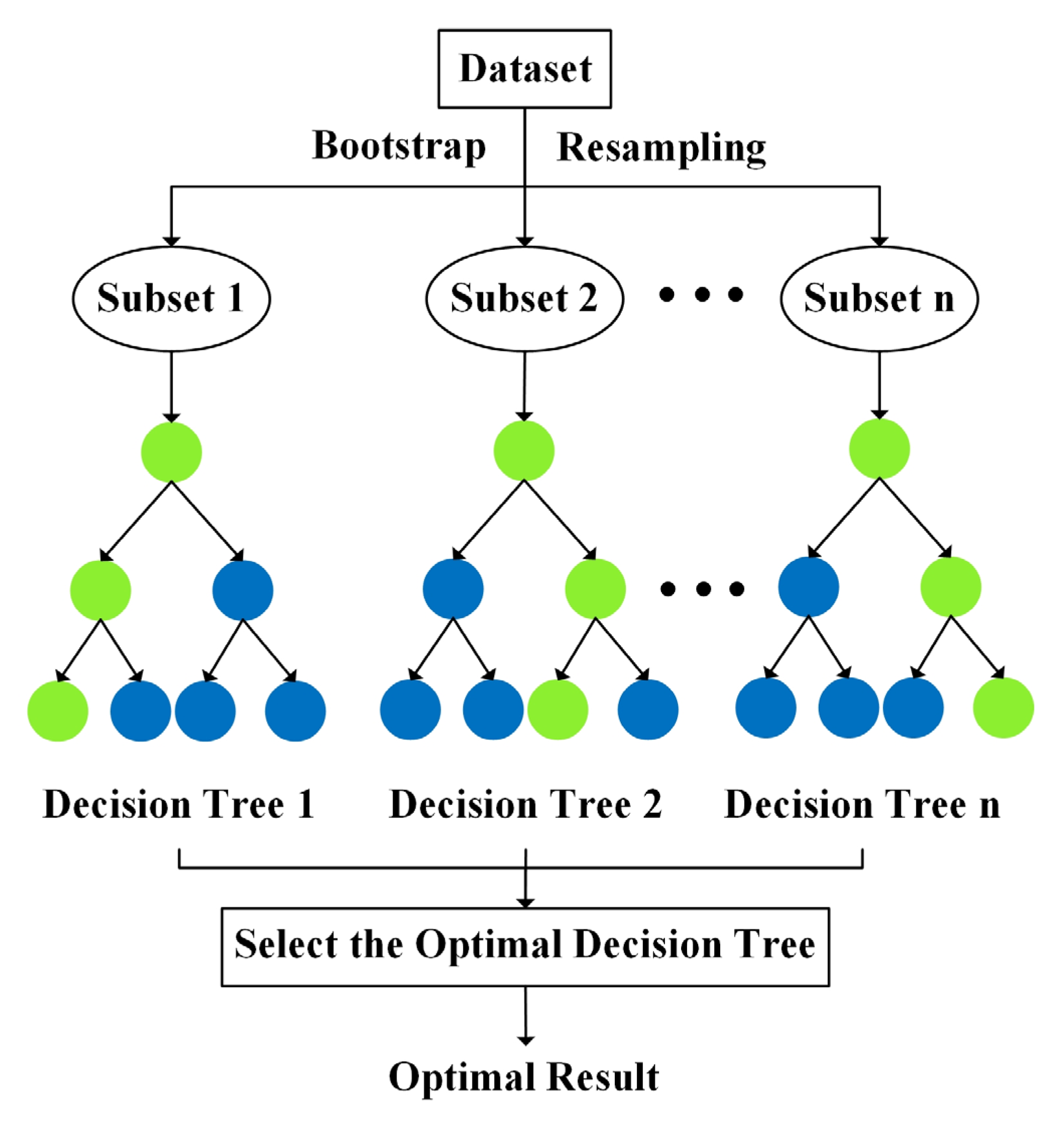

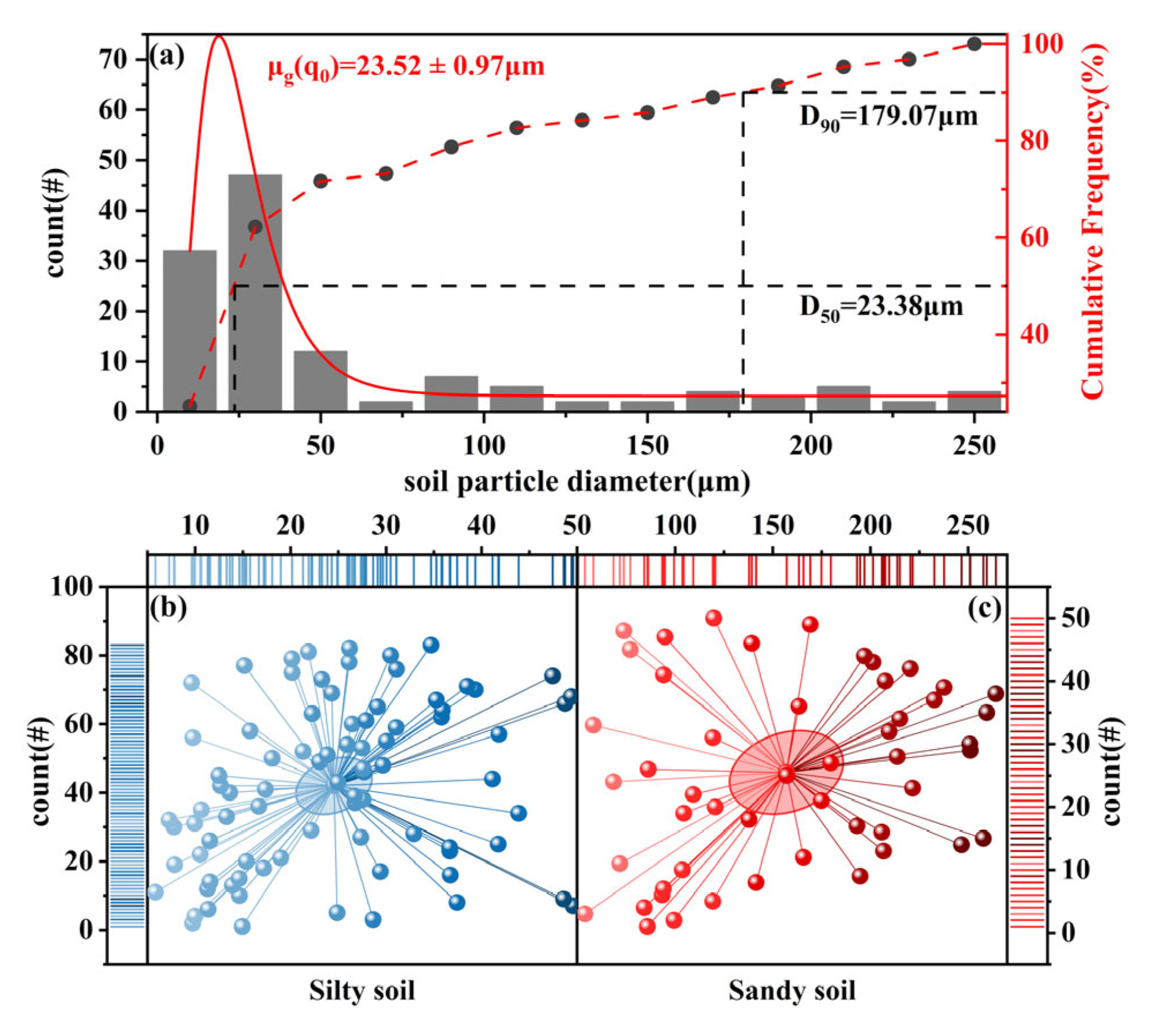
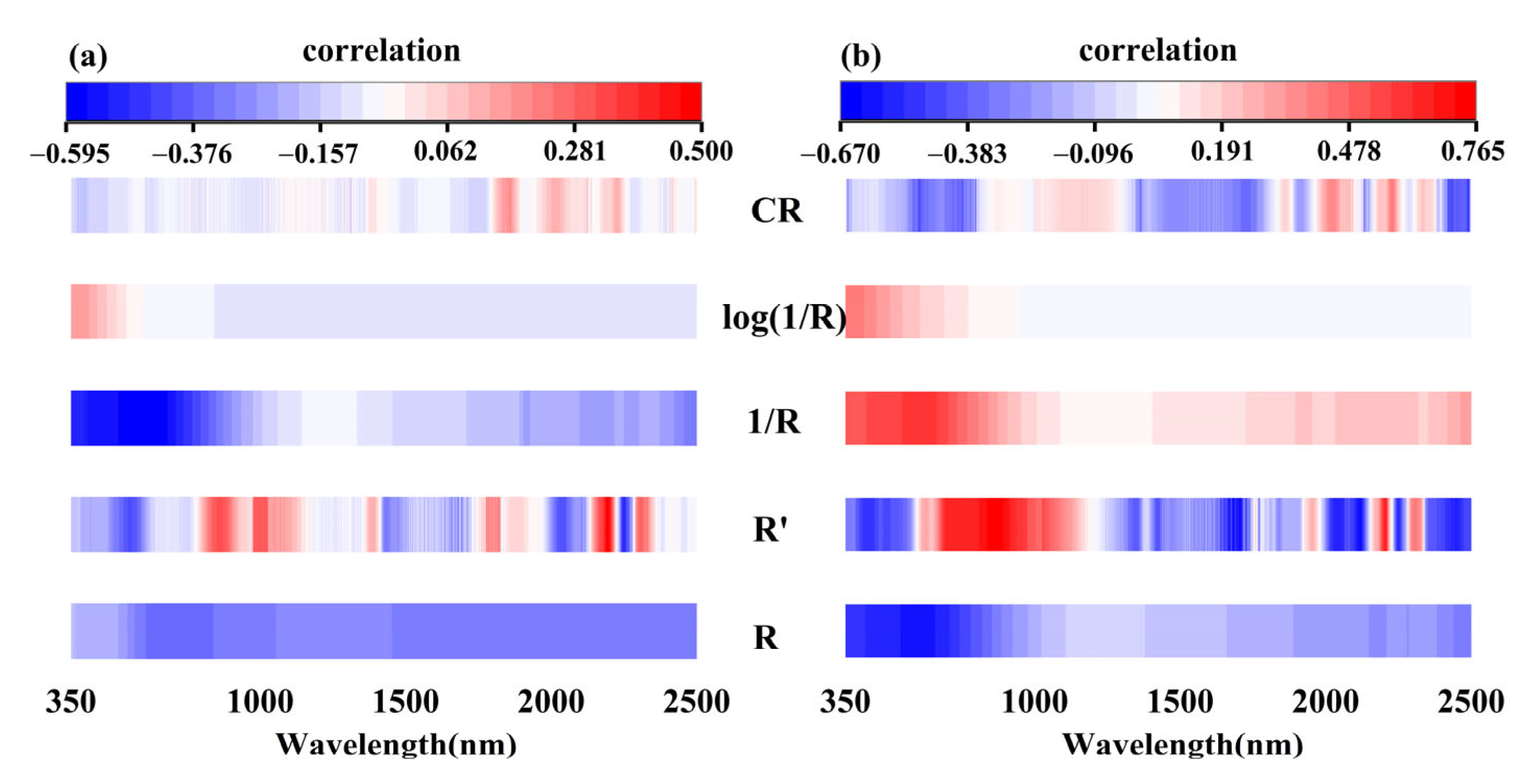

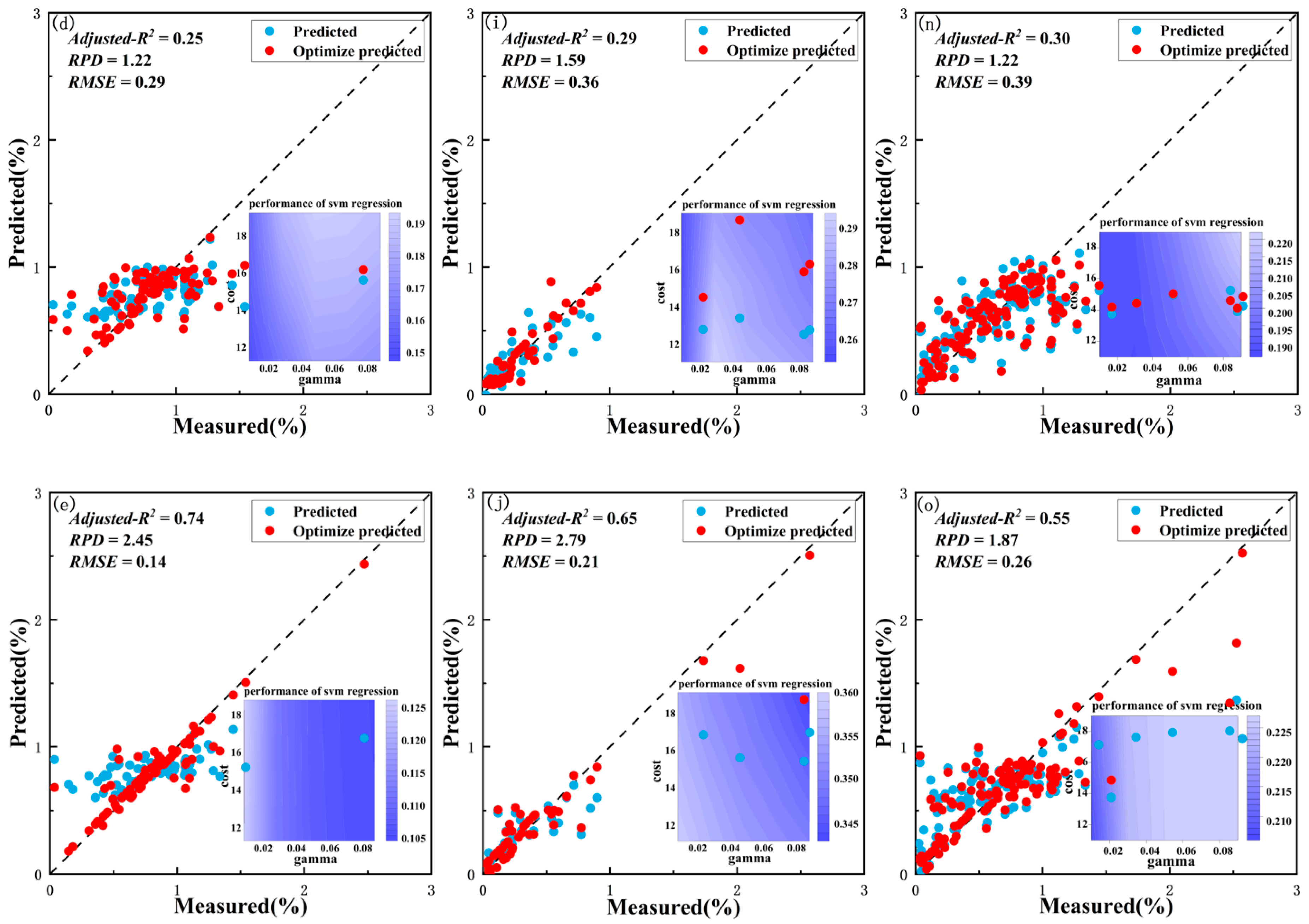
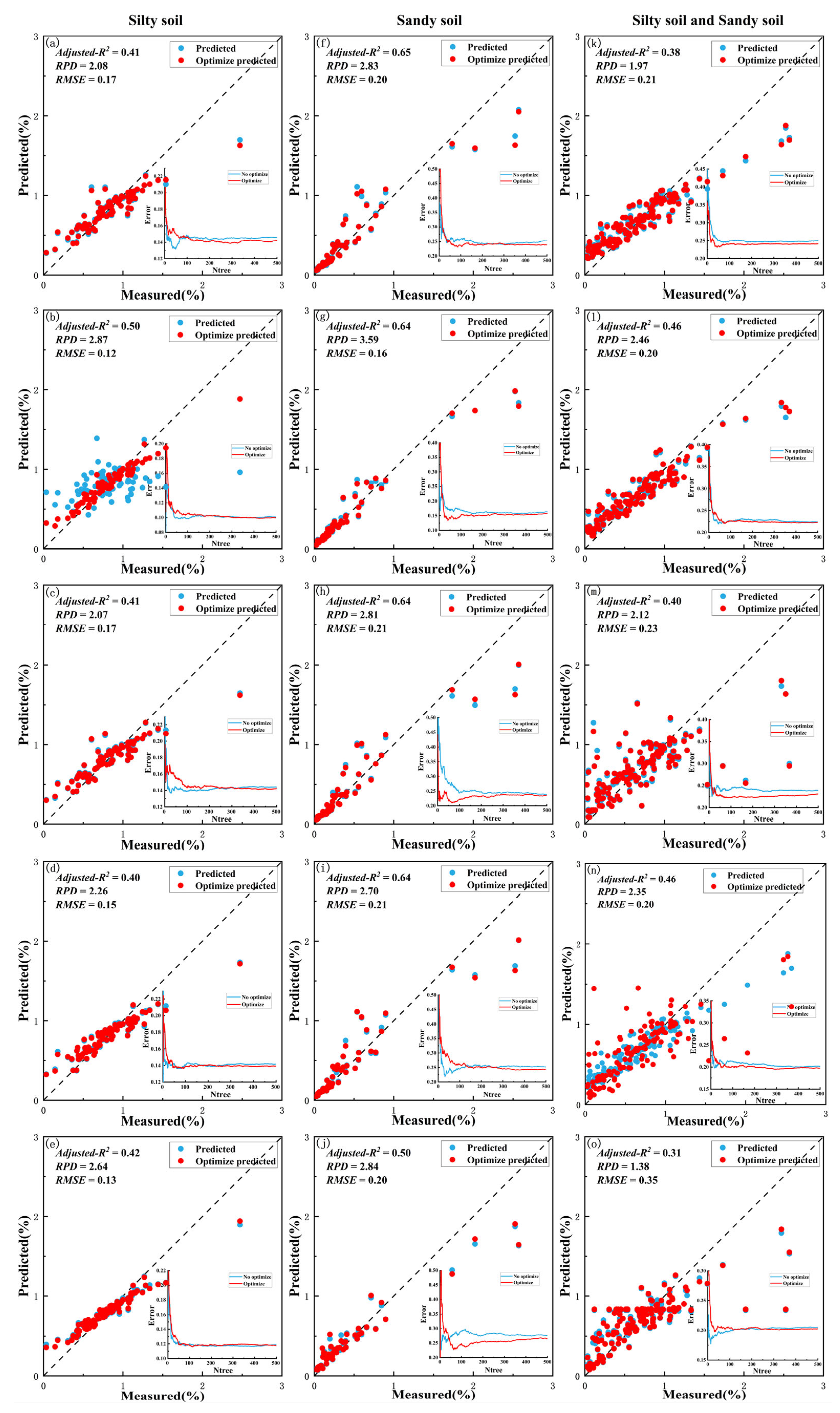

| Soil Texture | Unit | Number | Min | Max | Mean | Standard Deviation |
|---|---|---|---|---|---|---|
| silty | g kg−1 | 83 | 0.35 | 24.72 | 8.15 | 3.50 |
| sandy | g kg−1 | 50 | 0.26 | 25.72 | 4.52 | 5.77 |
| Soil Texture | Silty | Sandy | Silty and Sandy |
|---|---|---|---|
| mean | 8.15 | 4.51 | 6.78 |
| variance | 12.26 | 33.32 | 23.11 |
| observations | 83 | 50 | 133 |
| df | 82 | 49 | 131 |
| F | 0.67 0.31 × 10−5 0.66 | ||
| p (F ≤ f) one-tail | |||
| F critical one-tail | |||
| Texture | Transform Form | OSVR | ORFR | ||
|---|---|---|---|---|---|
| Cost | Gamma | Ntree | Mtry | ||
| silty | R | 11 | 0.09 | 500 | 301 |
| R′ | 11 | 0.01 | 500 | 451 | |
| 1/R | 11 | 0.09 | 500 | 301 | |
| log(1/R) | 11 | 0.01 | 500 | 301 | |
| CR | 19 | 0.09 | 500 | 451 | |
| sandy | R | 11 | 0.01 | 500 | 651 |
| R′ | 11 | 0.01 | 500 | 651 | |
| 1/R | 11 | 0.01 | 500 | 434 | |
| log(1/R) | 17 | 0.01 | 500 | 290 | |
| CR | 19 | 0.09 | 500 | 651 | |
| Soil Type | Characteristic Wavelength (nm) | References |
|---|---|---|
| field-moist soil | 400–800, 1380–1440, 1830–1950, 2090–2400 | [78] |
| cropland soil | 450–619, 760–909, 1968–2001 | [79] |
| spartina alterniflora wetland soil | 1400, 1900, 2200 | [4] |
| desert wetland soil | 745–910, 1911–2254 | [74] |
| coastal solonchaks | 1420, 1920, 2210 | [75] |
Publisher’s Note: MDPI stays neutral with regard to jurisdictional claims in published maps and institutional affiliations. |
© 2022 by the authors. Licensee MDPI, Basel, Switzerland. This article is an open access article distributed under the terms and conditions of the Creative Commons Attribution (CC BY) license (https://creativecommons.org/licenses/by/4.0/).
Share and Cite
Song, J.; Gao, J.; Zhang, Y.; Li, F.; Man, W.; Liu, M.; Wang, J.; Li, M.; Zheng, H.; Yang, X.; et al. Estimation of Soil Organic Carbon Content in Coastal Wetlands with Measured VIS-NIR Spectroscopy Using Optimized Support Vector Machines and Random Forests. Remote Sens. 2022, 14, 4372. https://doi.org/10.3390/rs14174372
Song J, Gao J, Zhang Y, Li F, Man W, Liu M, Wang J, Li M, Zheng H, Yang X, et al. Estimation of Soil Organic Carbon Content in Coastal Wetlands with Measured VIS-NIR Spectroscopy Using Optimized Support Vector Machines and Random Forests. Remote Sensing. 2022; 14(17):4372. https://doi.org/10.3390/rs14174372
Chicago/Turabian StyleSong, Jingru, Junhai Gao, Yongbin Zhang, Fuping Li, Weidong Man, Mingyue Liu, Jinhua Wang, Mengqian Li, Hao Zheng, Xiaowu Yang, and et al. 2022. "Estimation of Soil Organic Carbon Content in Coastal Wetlands with Measured VIS-NIR Spectroscopy Using Optimized Support Vector Machines and Random Forests" Remote Sensing 14, no. 17: 4372. https://doi.org/10.3390/rs14174372
APA StyleSong, J., Gao, J., Zhang, Y., Li, F., Man, W., Liu, M., Wang, J., Li, M., Zheng, H., Yang, X., & Li, C. (2022). Estimation of Soil Organic Carbon Content in Coastal Wetlands with Measured VIS-NIR Spectroscopy Using Optimized Support Vector Machines and Random Forests. Remote Sensing, 14(17), 4372. https://doi.org/10.3390/rs14174372








